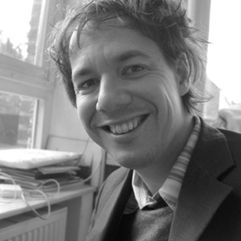

Mark Manders
1968 - Present
Mark Manders is a Dutch artist, currently living and working in Ronse, Belgium. His work consists mainly of installations, drawings and sculptures. He is probably best known for his large bronze figures that look like rough-hewn, wet or peeling clay. Typical of his work is also the arrangement of random objects, such as tables, chairs, light bulbs, blankets and dead animals.
Biography
Working as a graphic designer in his late teens, Manders studied at the Hogeschool voor de Kunsten in Arnhem (now ArtEZ Academy of Art & Design) from 1988 to 1992. During his studies, his fascination for design and language, and particularly poetry, further developed into a visual language of his own, where words were substituted by objects. His work soon gained widespread interest and in 1992, upon graduating from the academy, the artist was awarded the second prize at the Dutch Prix de Rome in the category Art & Public Space.
Together with Roger Willems and Marc Nagtzaam he founded Roma Publications 1988, 'as a platform to produce and distribute autonomous publications made in close collaboration with a growing number of artists, institutions, writers and designers'. Looking for an affordable larger studio, Manders emigrated to Belgium in 2007, where he found an abandoned small station building in Ronse.
Manders is represented by Zeno X Gallery, Antwerp, Tanya Bonakdar Gallery in New York City & Los Angeles and Gallery Koyanagi in Tokyo.
Work
Since 1986 Manders has been making Self-portrait as a building. The first of this series of fictional architectural plans was Inhabited for a Survey, (First Floor Plan from Self Portrait of a Building) (1986), where the plan is drawn on the floor of the gallery using pencils, crayons and other markers.
The fictional building represents a fictional artist, "Mark Manders", an alter-ego distinct from the artist Mark Manders. This fictitious character is described by the artist as a, "Neurotic, sensitive individual who can only exist in an artificial world." Each of his exhibitions includes an evolving floor plan of the self-portrait building along with various art works.
Manders uses this architecture to drive his work and allow it to make the decisions, calling it a "machine", but at the same time bringing objects to a standstill as he develops these memory spaces. Despite creating this fictional space, he insists on using "real objects" in the "real world" to make his sculptures.
I don't often show my work in the public domain, rather in museums where people choose to go to see art. But since 1991 I always test a work that I've just finished in a supermarket. I just imagine a new work there and I check if it can survive where it doesn't have the label of an artwork. It is just a thing that someone placed in a supermarket. Now I am sure that all of my works can stand in that environment." He often feels alien to the real world and its institutional art settings. He insists that his work stays the same throughout its exhibitions but gets re-contextualized each time it enters the "real world".
Text courtesy of Wikipedia, 2024









